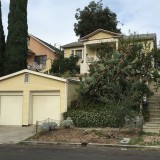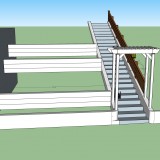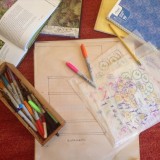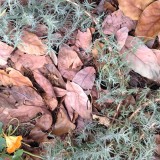
A bright spot is the new plantings: a hummingbird sage is blooming for Christmas
I’ve been putting off posting pictures of the plantings in our front yard because it just doesn’t look all that exciting at the moment. Everything is sleeping.
If this was a HGTV show, we’d make the big reveal at this point, and show you a stunning new landscape. Instead, what I have to show you are a bunch of tiny little plants swimming in a sea of dead leaves. The leaves are a light mulch that I’m using to protect my little plants from our still-harsh sun and occasional 80 degree days.
This is admittedly a terrible photo, but I’d dare a professional landscape photographer to make our front yard look good at this point. (Although I must say that’s a snazzy looking handrail!):

But it is truly all potential. There are wildflower seeds waiting to sprout and other surprises to come. I hope to be able to show you something wonderful this spring. So stay tuned. In the meantime, I will update this series if anything comes up– any new mistakes or discoveries or victories on the road to developing a meadow community.
Doing this project has made me aware of how often we expect instant results with our landscaping, and how this haste often comes at a price. I don’t mean money, though that is true as well. So often the homeowner or the designer installs way too many plants, and plants them too close to one another, so there is an instant sense of fullness in a newborn landscape.
It looks good for a while, but inevitably the plants start to choke one another out. This either results in a crazy looking landscape the year after the planting, or in lots of extra work for whomever is doing the maintenance, because they have to be pruning the plants back all the time to keep them in check. This isn’t only unnecessary labor, but it also wastes a good deal of fossil fuel what with the power tools and hauling, and if the clippings end up the landfill, the creation of methane gas. It may not be such a big deal in one yard, but it’s happening in thousands of yards, so the ill effects add up. The worst part is that it’s so very avoidable. We just have to learn to be a little bit patient.
So, I’m trying to be patient. I hope you will bear with us, too. (And here’s hoping the whole front slope doesn’t wash away in our El Niño rains!)






This looks fantastic — I’ve been waiting for an update! Landscaping this way is definitely more of a marathon than a sprint, but the end result is so worth it when you start to see nature taking its own course and the plants begin to hit maturity and reproduce on their own. I think this lends a much stronger connection to the garden as you watch the plants “grow up” and form relationships to each other (and the landscape) over time, rather than the instant gratification that we are used to. I’m excited to see how it goes-keep at it and good luck with the rains! (The leaves may be enough to prevent your seeds from washing away if they’ve had a chance to break down and become a bit matted before the rain, otherwise a light layer of straw may help too?)
Thanks, Andy! I’ve been tempted by the straw. It’s a bit of an eccentric mulch choice for the front yard, especially since it gets kinda yucky looking when it gets old and wet. But functionally, it is great. I may say the heck with it and do it anyway.
The handrail really is lovely and actually frames in the whole property nicely.
What is the tree in the upper right corner?
That’s our pomegranate. It’s now the queen of the slope, whereas before it was hidden.
I admire your front yard exploits and all the careful planning you’ve made. Unfortunately, I fall into the “plant ’em and dig ’em up” school of landscape design: I put in (zone-appropriate) plants I like and then when they inevitably grow too big/bushy/viney, I dig ’em up and move them somewhere more appropriate. I could really save myself a lot of time and effort by pre-planning.
We have recently moved and now own a charming, but badly-sided, Cape Cod. Once we have the siding replaced next year, I’m going to re-do the paltry front yard “garden”, which now consists of a mass of daylilies and a few straggly rhododendrons cooped up in a bed edged by pressure-treated lumber. Water is not an issue here. A recent issue of some Old House magazine featured an historic Cape with a lovely front garden surrounded by a (historically accurate) picket fence. I’m thinking of copying that and turning that small area directly in front of the house into a sort-of cottage garden. At least that’s what I’d like to do – it remains to be seen if I can pull it off.
Happy holidays to the Root Simple staff and readers!
Looks great. It takes time (and patience, that I, for one, rarely have.) I blogged about redoing our front space and making it in to a native Northern California woodland garden. For a long time, it looked pretty puny. But this past summer it was glorious, finally. There’s still some gum plant blooming even after several frosts and a hard freeze. So, I look forward to seeing your front meadow garden pictures as the yard evolves. Cheers!